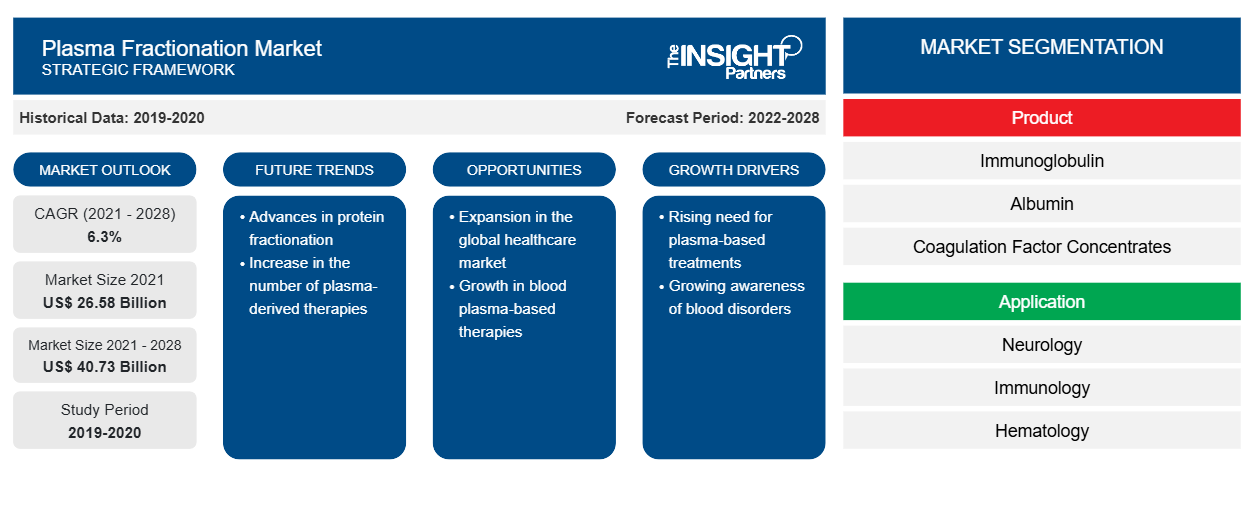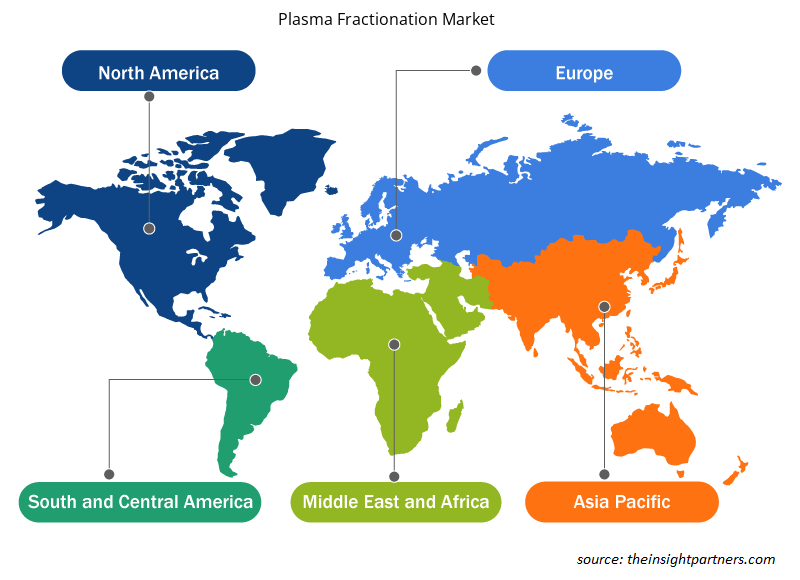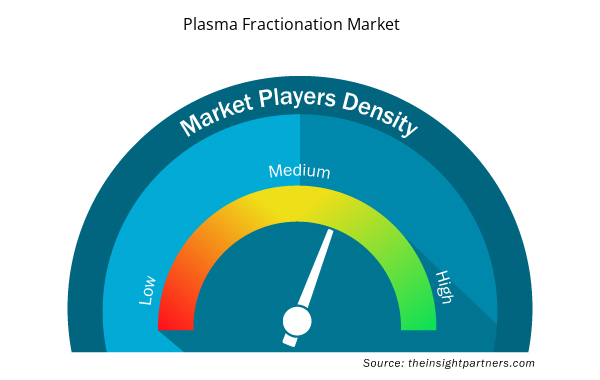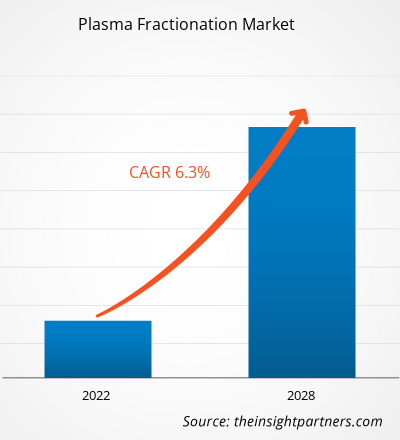[Research Report] The plasma fractionation market is expected to grow to US$ 40,731.98 million by 2028 from US$ 26,575.83 million in 2021; the plasma fractionation market is estimated to grow with a CAGR of 6.3% from 2021-2028.
Analyst Perspective
The growth of global plasma fractionation market is expected to grow due to the rising use of plasma therapy for treating novel diseases and increasing applications of plasma to design therapeutic products. In addition, during the COVID-19 pandemic, the demand for plasma therapy has surged, which has leveraged the growth of the plasma fractionation market. Moreover, the growing incidences of autoimmune diseases, infectious diseases, and immune diseases have served as vital growth opportunities for the market’s growth. The enhanced knowledge about the advantages of plasma therapy has increased plasma fractionation in developed countries. At the same time, developing countries are putting efforts to enhance their abilities to derive plasma and expand the use of plasma therapy. For instance, according to the Indian Government, the country has over 2 700 blood banks that collect nearly 10–11 million blood units annually. However, the statistics show that there is often a short supply of plasma in the country, and compared to developed countries, the usage of plasma derivatives per capita is less. However, the growing awareness and increasing investments in plasma fractionation in developed countries have paved the way for the growth of plasma fractionation in the market during 2021–2028.
Market Overview
The process of separating various components of blood plasma is known as plasma fractionation. The separated components are used to create various therapeutic plasma products that can be used to treat various medical conditions. Immunoglobulin, coagulation factors, albumins, and inhibitors are just a few of the plasma products commonly used. The growth of the plasma fractionation market is mainly driven by the factors such as the increasing application of plasma therapy and the active participation of the player companies in market developments that are propelling the market growth. However, the availability of recombinant or non-plasma Products is hampering the growth of the market. The global plasma fractionation market is segmented on the basis of product, application, and end user. Based on geography, the market is classified into North America, Europe, Asia Pacific, Middle East & Africa, and South and Central America. The North American region holds the largest market share of the plasma fractionation market, and Asia Pacific is estimated to be the fastest-growing region.
Customize This Report To Suit Your Requirement
You will get customization on any report - free of charge - including parts of this report, or country-level analysis, Excel Data pack, as well as avail great offers and discounts for start-ups & universities
Plasma Fractionation Market: Strategic Insights

- Get Top Key Market Trends of this report.This FREE sample will include data analysis, ranging from market trends to estimates and forecasts.
Customize This Report To Suit Your Requirement
You will get customization on any report - free of charge - including parts of this report, or country-level analysis, Excel Data pack, as well as avail great offers and discounts for start-ups & universities
Plasma Fractionation Market: Strategic Insights

- Get Top Key Market Trends of this report.This FREE sample will include data analysis, ranging from market trends to estimates and forecasts.
Market Driver
Rising Application of Plasma Therapy
Blood plasma is among the emerging method for treating various chronic diseases. The plasma consists of essential components, such as proteins, albumin, globulins, fibrinogen, clotting factors and inhibitors, and others. It is widely used in blood cancer, COVID19, Atrial fibrillation, leukemia, and others. The plasma is separated from the donated blood by using plasma Fractionation. The regulatory agencies are also providing the required approvals for the use of plasma in treatment processes. For instance, in August 2020, the US Food and Drug Administration (USFDA) issued the emergency use authorization (EUA) for convalescent plasma treatment of COVID–19. In addition to this, in February 2021, the USFDA issued an updated guideline for the plasma EUA for COVID19. Thus, active involvement and approval by the regulatory and government are expected to encourage the application of blood plasma. The blood plasma can be stored for up to one year by freezing within 24 hours of blood donated to protect the valuable clotting factors and can be used post thawing process. Many blood bank settings are established in every country worldwide, have access to healthcare service providers, and are funded by various governments and other organizations. For instance, in 2021, the American Association of Blood Banks (AABB) granted funding for the research projects such as “Engineering Immunotherapy Resistant Hematopoiesis to Treat High-Risk Acute Myeloid Leukemia” (by Pietro Genovese, BSc, MSc, Ph.D., Assistant Professor in Pediatrics, Gene Therapy Program, Dana-Farber/Boston Children’s Cancer and Blood Disorder Center, Dana-Farber Cancer Institute), “New Approaches to Study and Treat Alloantibody-Mediated Diseases Resulting from Blood Transfusions” (by Simon J. Cleary, Ph.D.; Postdoctoral Fellow, Medicine-Pulmonary, University of California.) and others. Therefore, as per the above-stated factors, the blood plasma fractionation related market in the forecast period.
Segment Analysis
The global plasma fractionation market is segmented on the basis of product, application, and end user. Based on the product, the market is segmented into immunoglobulin, albumin, coagulation factor concentrates, protease inhibitors, and others. The immunoglobulin segment is likely to hold the largest share of the market in 2021. Moreover, it is anticipated to register the highest CAGR in the market during 2021–2028. This segment is expected to contribute considerably to the market in the forecast period owing to the increasing prevalence of infectious diseases and the active support of the government and regulatory agencies in product developments and approvals. For instance, in May 2021, the US Food and Drug Administration (FDA) issued an emergency use authorization for the investigational monoclonal antibody therapy 'Sotrovimab' to treat mild-to-moderate COVID-19 in adults and pediatric patients. Further, the immunoglobulin is subsegmented into intravenous immunoglobulin, subcutaneous, and others.
Based on the application, the market is segmented into neurology, immunology, hematology, critical care, pulmonology, and others. In 2021, the neurology segment held the largest market share of the plasma fractionation market. However, the hematology segment is expected to witness growth at the fastest CAGR from 2021 to 2028, owing to the rise in the detection and diagnosis of various medical conditions across the globe.
Based on the end user, the market is segmented into hospitals and clinics, clinical research laboratories, and academic institutes. In 2021, the hospitals and clinics segment is likely to hold the largest share of the market. Moreover, the clinical research laboratories segment is also expected to witness growth in its demand at the fastest CAGR from 2021 to 2028, owing to the rise in the detection and diagnosis of various medical conditions across the globe.
Regional Analysis
North America held the largest market share of the global plasma fractionation market, valued at US$ 9,484.91 million in 2021 and estimated to grow at a CAGR of 6.5% from 2021–2028. The North American plasma fractionation market is divided into the US, Canada, and Mexico. The growth of the market in the region is widely attributed to the growing application of coagulation factor concentrates, clotting factor concentrates, and other plasma-derived products to treat various hematological disorders such as hemophilia A, hemophilia B. Moreover, the growth of the market in Canada is expected to grow due to the increasing prevalence of multiple sclerosis and other neurological disorders. In addition, in Mexico, the market is estimated to grow owing to increasing awareness about blood and related disorders and immunological disorders, along with rising awareness about plasma-derived therapies in the treatment of chronic disorders. On the other hand, the Asia Pacific is expected to grow at the fastest CAGR during 2021 to 2028. The growth of the market in the region is attributed to the growing interest of international players in China and India, government support in countries such as China, and advancing healthcare infrastructure. Therefore, the region holds huge potential for the plasma fractionation market players to grow during the forecast period.
Key Player Analysis
The plasma fractionation market majorly consists of the players such as Bio Products Laboratory LTD, CSL Limited, Biotest AG, Sanquin, Bharat Serums and Vaccines Limited, Grifols S.A, Kedrion, SK Plasma, Plasmagen Biosciences PVT. LTD, Octapharma AG, amongst others. The two leading players in the market are CSL Limited and Grifols S.A. These companies are involved in various organic and inorganic developments that have paved the way for significant growth opportunities.
Plasma Fractionation Market Regional Insights
Plasma Fractionation Market Regional Insights
The regional trends and factors influencing the Plasma Fractionation Market throughout the forecast period have been thoroughly explained by the analysts at Insight Partners. This section also discusses Plasma Fractionation Market segments and geography across North America, Europe, Asia Pacific, Middle East and Africa, and South and Central America.

- Get the Regional Specific Data for Plasma Fractionation Market
Plasma Fractionation Market Report Scope
| Report Attribute | Details |
|---|---|
| Market size in 2021 | US$ 26.58 Billion |
| Market Size by 2028 | US$ 40.73 Billion |
| Global CAGR (2021 - 2028) | 6.3% |
| Historical Data | 2019-2020 |
| Forecast period | 2022-2028 |
| Segments Covered |
By Product
|
| Regions and Countries Covered | North America
|
| Market leaders and key company profiles |
Plasma Fractionation Market Players Density: Understanding Its Impact on Business Dynamics
The Plasma Fractionation Market market is growing rapidly, driven by increasing end-user demand due to factors such as evolving consumer preferences, technological advancements, and greater awareness of the product's benefits. As demand rises, businesses are expanding their offerings, innovating to meet consumer needs, and capitalizing on emerging trends, which further fuels market growth.
Market players density refers to the distribution of firms or companies operating within a particular market or industry. It indicates how many competitors (market players) are present in a given market space relative to its size or total market value.
Major Companies operating in the Plasma Fractionation Market are:
- BASF SE
- TMIC
- Creative Proteomics
- BGI
- RTI International
Disclaimer: The companies listed above are not ranked in any particular order.

- Get the Plasma Fractionation Market top key players overview
Recent Developments
Companies in the plasma fractionation market highly adopt inorganic and organic strategies. A few recent key market developments are listed below:
- In April 2020, Grifols, a global manufacturer of plasma-derived medicines, announced the launch of a new 3-mL vial of HyperRAB, which is used to treat postexposure prophylaxis for rabies. The US Food and Drug Administration had already approved this vial in 2019.
- In May 2021, Liminal BioSciences Entered into an Agreement with Kedrion to Divest Its Plasma Collection and Plasma-Derived Therapeutics Business.
- In April 2021, BPL and Atlantic Research Group entered into a long-term collaboration. This agreement establishes ARG as BPL's preferred contract research organization (CRO) for conducting clinical research trials and providing supportive services for the company's global new product development programs. The agreement builds on BPL and ARG's previous successful collaboration on clinical trial programs.
- Historical Analysis (2 Years), Base Year, Forecast (7 Years) with CAGR
- PEST and SWOT Analysis
- Market Size Value / Volume - Global, Regional, Country
- Industry and Competitive Landscape
- Excel Dataset



Report Coverage
Revenue forecast, Company Analysis, Industry landscape, Growth factors, and Trends

Segment Covered
Product, Application, End User, and Geography

Regional Scope
North America, Europe, Asia Pacific, Middle East & Africa, South & Central America

Country Scope
Argentina, Australia, Brazil, Canada, China, France, Germany, India, Italy, Japan, Mexico, RoAPAC, RoMEA, RoSCAM, Saudi Arabia, South Africa, South Korea, Spain, United Arab Emirates, United Kingdom, United States
Frequently Asked Questions
The global plasma fractionation market is being driven by factors such rising application of plasma therapy and active participation of the players in market developments, development potential in emerging countries are likely to offer significant opportunities for the growth of the global plasma fractionation market.
The Asia Pacific is expected to be the fastest-growing region in the plasma fractionation market. The growth of the market in this region is primarily due to the rising application of plasma therapy and the active participation of the players in market developments
The process of separating various components of blood plasma is known as plasma fractionation. The separated components are used to create a variety of therapeutic plasma products that can be used to treat a variety of medical conditions. Immunoglobulin, coagulation factors, albumins, and inhibitors are just a few of the plasma products commonly used.
The availability of non-plasma products is the significant factor that will hinder the plasma fractionation market growth.
The market players in the global market in constantly involved in the product development and innovations as part of their business strategies such as product launch, mergers and acquisitions, partnership and others. For instance, in July 2020, Grifols has entered into purchase agreements with South Korean-based GC Pharma (Group) through which the company would buy a plasma fractionation plant and two purification facilities in Montreal and 11 plasma collection locations in the United States, a total of US$460 million.
The key players in the global plasma fractionation are Bio Products Laboratory LTD, CSL Limited, Biotest AG, Sanquin, Bharat Serums and Vaccines Limited, Grifols S.A, Kedrion, SK Plasma, Plasmagen Biosciences PVT. LTD, Octapharma AG and among others.
Trends and growth analysis reports related to Life Sciences : READ MORE..
The List of Companies - Plasma Fractionation Market
- BASF SE
- TMIC
- Creative Proteomics
- BGI
- RTI International
- Afekta Technologies Ltd.
- Fred Hutchinson Cancer Research Center
- West Coast Metabolomics Center
- Molecular You
- Metabolon, Inc.
- biocrates life sciences ag
- Chenomx Inc.
- C-CAMP
- metaSysX
- MS-Omics

 Get Free Sample For
Get Free Sample For